Discover how to grow, care for, and design with yellow tulips in 2025. Learn expert tips, fix yellowing leaves, and explore top varieties—all from my decade of hands-on experience.
Hi, I’m Anna Scott, founder of USA Garden Hub, and I’ve spent the last 10 years helping gardeners across the U.S. grow vibrant, healthy tulips. There’s something magical about yellow tulips—they’re like sunshine in your garden. But over the years, I’ve seen folks struggle with issues like drooping blooms or yellowing leaves. Let me share everything I’ve learned to help you grow stunning yellow tulips in 2025, whether you’re a newbie or a seasoned green thumb.
Here’s a chart with detailed information about yellow tulips:
| Category | Information |
|---|---|
| Botanical Name | Tulipa spp. |
| Common Name | Yellow Tulips |
| Plant Type | Perennial Bulb |
| Hardiness Zone | Zones 3-8 |
| Sun Exposure | Full Sun to Partial Shade |
| Soil Type | Well-drained, sandy or loamy soil |
| Watering | Moderate; water during growth, less after blooming |
| Growth Habit | Upright |
| Height/Spread | 10-24 inches tall, 6-12 inches wide |
| Special Features | Bright yellow blooms; Ideal for spring gardens; Deer-resistant |
Why Yellow Tulips? Symbolism & Trends for 2025

Yellow tulips symbolize joy, friendship, and new beginnings—perfect for modern gardens focused on positivity. In 2023, a client asked me to design a memorial garden using yellow tulips to honor her late sister’s cheerful spirit. We chose ‘Golden Apeldoorn’ varieties, and today, that garden is a local landmark.
2025 Trend Alert: Expect to see more bi-color yellow tulips (like ‘Mysterious Parrot’) and compact varieties for container gardening.
Top 5 Yellow Tulip Varieties to Plant in 2025
1. ‘Yellow Crown’ (Single Late Tulip)
- Why I Love It: Holds up well in rain (a lifesaver in Midwest springs!).
- Pro Tip: Pair with purple alliums for contrast.
2. ‘Coonoor Yellow’ (Darwin Hybrid)
- Unique Trait: Rare, lemon-scented blooms discovered in Tamil Nadu, India.
- Best For: Warm climates (Zone 8-10).
See my Creating Beautiful Tulip Bouquets : The Ultimate Guide for more options.
Step-by-Step Planting Guide
When to Plant
Plant bulbs 6-8 weeks before your first hard frost. In Vermont, I aim for October 15th—any earlier, and voles feast on them!
Where to Plant
- Sun: 6+ hours daily (morning sun prevents scorching).
- Soil: Well-draining mix with compost. Test pH using Esophageal pH Test.
How to Plant
- Dig 6-8” deep (triple the bulb’s height).
- Add 1 tbsp bone meal per bulb.
- Water once, then wait for sprouts.
Mistake I Made: Planting near walnut trees (their juglone toxin stunted my 2018 crop).
Caring for Yellow Tulips: My 10-Year Routine
Watering
- Spring: 1” weekly if no rain.
- Summer: Stop after blooms fade (bulbs need dry dormancy).
Fertilizing
Use 10-10-10 NPK fertilizer when leaves emerge. My grandma swore by fish emulsion—it works!
Deadheading
Snip spent blooms but leave foliage until it yellows. In 2021, I trimmed leaves too early and got 50% fewer flowers the next year.
Troubleshooting: “Why Are My Tulip Leaves Turning Yellow?”
Common Causes:
- Overwatering: Soggy soil = rotten bulbs. Stick your finger 2” down—if wet, hold off.
- Tulip Fire Disease: Curled leaves with brown spots. Sadly, I lost 20 bulbs to this in 2019. Dig up and destroy infected plants.
- Natural Dormancy: Post-bloom yellowing is normal.
Fix It Fast: Spray aphid-prone leaves with my garlic spray recipe.
Designing with Yellow Tulips: 3 Showstopping Ideas
1. The “Sunrise Border”
- Combo: Yellow tulips + blue forget-me-nots + red coral bells.
- Pro Tip: Plant in waves for staggered blooms.
2. Container Gardens
Use dwarf ‘West Point’ tulips in pots with trailing ivy.
3. Cut Flower Displays
Cut stems diagonally at dawn and add 1 tsp sugar to vase water (learned from RHS expert).
Frequently Asked Questions
Q: Do yellow tulips come back every year?
A: Most are perennial in Zones 3-7. In warmer areas, treat as annuals or refrigerate bulbs pre-planting.
Q: Where can I buy ‘Coonoor Yellow’ tulips?
A: Check Longfield Gardens—they shipped me healthy bulbs last fall.
Final Thoughts
Yellow tulips have brought me a decade of joy, from my first wobbly seedlings to the 500-bulb display I grow today. Start small, learn from mistakes (like my walnut tree fiasco!), and soon you’ll have golden blooms that make neighbors stop and smile.
Need Help? Grab my free tulip care calendar or share your yellow tulip photos with #USAGardenHub!






